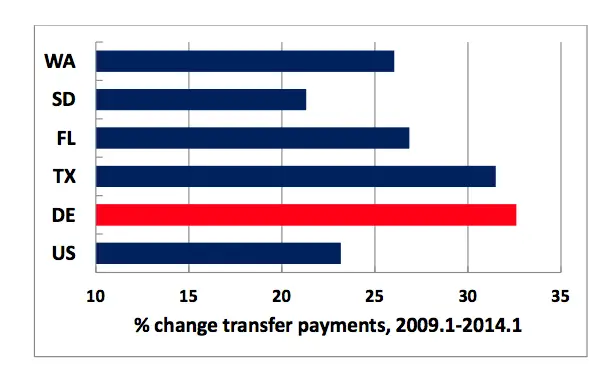The Delaware economy continues to be a puzzle. The year over year employment growth rate remains strong above 2 percent, yet the state’s unemployment rate has been rising for three months. In August the Delaware unemployment rate jumped up to 6.5 percent while the national rate fell to 6.1 percent. And this jump occurred as the initial claims for unemployment in Delaware continued to steadily drop. What is going on?
One hypothesis is that Delaware residents perceive the economy to be turning around and are flooding back into the labor force looking for jobs. The state’s civilian labor force has increased 2 percent over the last 12 months, an accelerated rate compared to the years since the recession. However, the number of Delaware residents who have jobs has risen at the even faster rate of 2.3 percent. So hiring of residents has kept pace with the growth in the state’s labor force.
The more plausible explanation is the type of jobs that are growing in Delaware. While the unemployment claims data provides useful information for estimating Delaware’s unemployment rate, it understates the extent of unemployment because it excludes several important groups. To begin with, not all workers are covered by UI programs. For example, self-employed workers, unpaid family workers, workers in certain not-for-profit organizations, and several other worker categories (primarily seasonal and temporary) are not covered. It also does not include workers who have exhausted their benefits, not yet qualified for benefits, or do not file for benefits (on average just one-third of the total unemployed receive UI benefits). An estimate of these other groups of workers are included in the monthly Current Population Survey (CPS) conducted by the Bureau of the Census.
Among other questions, the monthly CPS asks how many members of a household are working or looking for work. Almost two- thirds of the jobs being added in Delaware are short-term or part-time. This includes the thousands of temporary jobs at the new Amazon warehouse in Middletown and jobs added in retail trade and leisure and hospitality. The average time in a job across all industries in the U.S. is 4.6 years. Obviously this is not the case for temp and seasonal positions. This rapid turnover can explain why the CPS measure of unemployed Delaware residents is rising, even when initial claims for unemployment are dropping.
THE CONSEQUENCES OF THE STRUCTURAL SHIFT
The shift to lower paying jobs is reflected in slower growth in Delaware personal income, especially earnings, over the past five years. Between 2009Q1 and 2014Q1 total personal income rose 17.8 percent in Delaware and 19.4 percent in the U.S. Meanwhile personal income increased from 19 percent to 28 percent in the four states with no state personal income tax.
The driving force behind the differences in the growth rates of personal income has been the growth rates in earnings (wages and salaries). Total earnings in Delaware rose 15 percent compared to 19 percent across the nation and as high as 30 percent in Texas. Consequently, over this time period the inflation-adjusted median earnings of Delaware workers has declined. And average inflation-adjusted income of Delaware households has dropped 7 percent, with the inflation-adjusted median household income falling by 9 percent.
Not surprisingly, total Delaware transfer payments (e.g., Social Security, Medicaid, Medicare, SSI, SNAP) jumped 32 percent compared to 23 percent across the U.S. The total number of Delawareans receiving SSI rose 53 percent and the number receiving food stamps nearly doubled (up 94 percent). – Dr. John E. Stapleford, Principal
DECON First Expects positive but slower job growth for the remainder of 2014 as the temp warehousing hiring tails off. The unemployment rate will stabilize. Slow personal income growth will become a drag on residential construction and overall housing sales. Sustaining government transfer programs will require an increase in taxes.
DECON First uses economics to strengthen Delaware business. This is accomplished by providing accurate, objective, and relevant analysis of the economy of Delaware and southeastern Pennsylvania through consulting and retainer contracts. DECON First helps identify potential customers, performs project feasibility analysis, estimates asset default risk, and provides 24/7 professional insights through the “virtual economist.” Visit www.deconfirst.com for more information and direct questions to info@deconfirst.com




